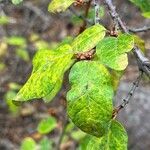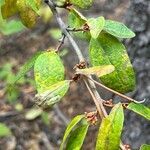A spreading shrub. It grows 2.4 m high and spreads 2.4 m wide. It does not have thorns. The young twigs and buds are covered with reddish-brown scales. The leaves are are oval and dark yellowish green. They are white underneath. Plants are separately male and female. The flowers are creamy yellow. The fruit are yellow or red.


